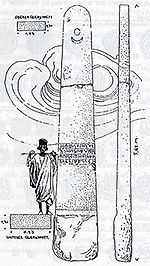Hawulti (monument)
The Hawulti is a pre-Aksumite or early Aksumite era obelisk located in Matara, Eritrea. It bears what has been described as the oldest known example of the old Ge'ez script (also known as "Old Ethiopic").[1]
Description
The monument is 18 feet high, with a solar disk and a lunar crescent at the top; Ullendorff believes these symbols "no doubt meant to place the stele under the protection of the gods, probably of Šams, the Sun goddess, and of Sin, the Moon god". These pre-Christian symbols, as well as paleolographical characteristics as the lack of vowel marks in the Ge'ez script, convinced Ullendorff that the monument dated "to the early part of the fourth century A.D."[2]
Ullendorff translated of the inscription as follows:
- This is the obelisk which had (causative) made
- 'Agaz for his fathers who have
- carried off the youth of 'W`
- 'LF as well as of SBL.
His translation differs from Enno Littmann at several points. First, Littmann believed the third line referred to the digging of canals nearby (his translation, "zog die Kannaele von `Aw`a") despite the lack of any signs of canals or ditches in the area; Ullendorff argues that the verb shb in the inscription should be translated as "to drag along, to capture". Second, he believed the nouns -- 'W`, 'LF, and SBL -- were placenames, and based on discussions with local informants Ullendorff identified them with nearby communities: the earlier name of Baraknaha, the site of a 12th-century church 17 kilometers from Matara, had been subli, and the equally well-known church at Guna Guna, 22 kilometers from Matara, had once been known as Aw`a 'ilfi.[3]
Modern history
When Littmann, leader of the Deutsche Aksum-Expedition, found the Hawulti, it been pushed over and broken in half in the distant past. The Italian colonial government afterwards had the broken monument repaired with two iron bars and set upright in what thought to be its proper location; however, its exact original location is not known for sure.[4]
The Hawulti was toppled and damaged[5][6] by Ethiopian troops in the short occupation of southern Eritrea during the Eritrean-Ethiopian War. It has since been repaired by the National Museum of Eritrea.[7]
References
- ↑ Edward Ullendorff, "The Obelisk of Matara," Journal of the Royal Asiatic Society of Great Britain and Ireland, No. 1/2 (April, 1951), pp. 26-32
- ↑ Ullendorff, "Obelisk of Matara", p. 28
- ↑ Ullendorff, "Obelisk of Matara", p. 31
- ↑ Ullendorff, "Obelisk of Matara", p. 26
- ↑ "Ethiopian Army Destroys World Heritage". 2001-05-18. Retrieved 2006-09-09.
- ↑ "Matara:Most recent information". Retrieved 2006-09-10.
- ↑ "Ancient statue at Belew Kelew repaired". 2005-05-14. Retrieved 2006-09-10.
